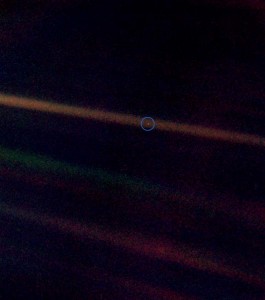
Sometimes, the best valentines are those that arrive late, long after the roses have withered and the chocolates have been consumed.
At around the same time that I started high school, NASA’s Voyager 1 spacecraft blasted off on its journey to the outer planets. Thirteen years later and nearing the end of its planned primary mission, it turned its onboard cameras back toward the centre of our solar system. On February 14th, 1990, Voyager 1 took what is commonly known as the Pale Blue Dot image of Earth.
Since romance is never a high priority, except in the movies, the signals sending back the packages of information that made up the image could not be delivered until the following month. With a transit time of around five and a half hours, the images slowly accumulated as an array of Voyager’s last peek at its home before heading out to the farthest reaches of our solar system and beyond.
Pale Blue Dot and the solar system family portraits are the final photographs taken and submitted by Voyager 1. Computing power and data collection systems were reprogrammed for the onward mission at that point.
Distance can indeed make the heart grow fonder. Both Voyagers (Voyager 2 launched a couple of weeks before 1) are farther away from the Sun than Pluto, and are either in interstellar space (Voyager 1) or about to make that transition. Both still transmit data, and both are still lovingly cared for by a team at NASA that sends regular maintenance and mission updates via the Deep Space Network.
In my opinion, Pale Blue Dot is one of the coolest and most romantic Valentine’s Day gifts ever. Sent 25 years ago, without emotion, from a collection of wire, metal and chips at the distant edges of our solar system…it arrived late, but it got here, hopefully just in time.